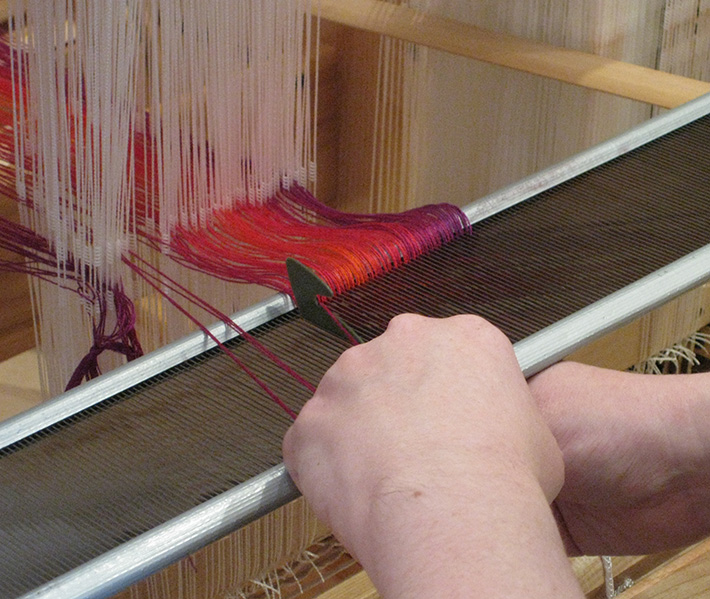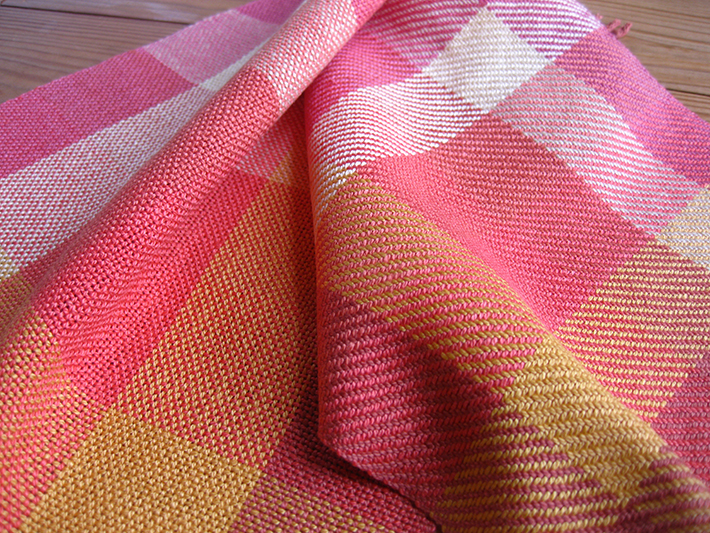One of a weavers’ most frequently asked questions must be, “What sett do I need for this yarn?” And, the most frequently given answer surely must be, “It depends what you plan to do with it.”
It’s annoying, but it’s true. Sett depends on three different things: the yarn, the weave structure and the end purpose of the project. Vary any one of those things and the sett you used successfully last time might turn out to be less than ideal this time. This is why the weaver’s mantra is “Sample, sample, sample!”
FREE Guide: 7 Simple Scarf Tips Every Weaver Should Know

Download this free PDF guide and get 7 great tips for weaving success in every scarf project!
But you can’t start sampling unless you have at least a ballpark figure to begin with, so how do we get anything onto the loom at all?
Here’s how to go about finding the right sett
 Yarn
Yarn
The first thing to do is to consider your yarn. If you have bought a fairly standard weaving yarn – a 10/2 cotton, for instance – then there a number of resources which can help.
Many weaving suppliers offer a basic guide on their website, so do an internet search for your yarn and see what is said about it. Very often you will see a yarn description include either a range, e.g. 24-30 epi, or a triplet of numbers, e.g. (24, 27, 30). These are telling you the same thing.
The smallest number in the range, i.e. the most open sett, is the suggested sett for a lace weave.
 The largest number is the suggested sett for a twill. If three numbers are given then the middle number is the suggested sett for a balanced plain weave. Sett information for a wide range of yarns is also given in the Handwoven Magazine Master Yarn Chart.
The largest number is the suggested sett for a twill. If three numbers are given then the middle number is the suggested sett for a balanced plain weave. Sett information for a wide range of yarns is also given in the Handwoven Magazine Master Yarn Chart.
If sett information is not readily available for your yarn then you can find a starting point for yourself by making a wrapping. This is a technique knitters use as well, and Ashley Little wrote a great blog about it here. After you have counted your wraps per inch (wpi) you need to translate that into sett. The main ‘rules of thumb’ are:
- For a balanced plain weave your sett should be half your wpi
- For a balanced twill your sett should be two-thirds of your wpi
Structure
We have already seen that different starting setts are recommended for different structures. The main thing driving this difference is the number of interlacements in the structure, i.e. the number of times the weft needs to go over and under the warp. The more interlacements there are, the more space the weft yarn is going to need in order to get through!
In plain weave the weft passes over or under each warp end individually, so the web is very heavily interlaced. In a twill, the weft typically passes over two or three warp ends in a group, so the interlacement is less frequent. That’s what gives twill fabrics their lovely handle, but they need to be sett more closely than plain weave or they will turn out sleazy and unstable.
I wove these two color gamps on the same warp, one in plain weave and one in 2/2 twill. I had to cut off the plain weave piece and resley more closely for twill in order to weave the second gamp.
 For more complex structures you will have to dig a little deeper. If you consult a weaving reference book or an article about the structure you plan to use, the author will almost certainly recommend a general approach, e.g. “Use a plain weave sett” or “This works well if the sett is a little closer than plain weave”, which you can then interpret for your particular yarn.
For more complex structures you will have to dig a little deeper. If you consult a weaving reference book or an article about the structure you plan to use, the author will almost certainly recommend a general approach, e.g. “Use a plain weave sett” or “This works well if the sett is a little closer than plain weave”, which you can then interpret for your particular yarn.
Purpose of the project
Ultimately, your yarn and your structure are there to serve your project. The technical information will give you a starting point, but then you need to think about what you want to achieve.
Do you actually want a balanced twill? Many weavers prefer a slightly more warp-faced twill, and the beautiful drape this produces, so would choose to increase the sett a little over the recommended number.
Are you planning to sew with your fabric? The recommended sett may be perfect for a scarf, but if you want to make garments then your fabric needs to be much more firmly woven: you will probably want to increase the sett substantially. The first time I wove yardage for a garment I used 8/2 Tencel in the warp. I started sampling at the recommended twill sett of 24 epi, gradually increasing until I ended up weaving it at 32 epi. And when I came to sew it, I reckoned that 36 epi would have been better! So consider increasing the sett by 25 – 50% if you want to be able to cut out and sew your handwoven cloth.
On the other hand, if you are weaving a lacy summer scarf, then you may want to show off that lovely lace patterning with a more open sett.
Finally, don’t forget that you will need to adjust your beat to correspond with your sett. A tightly-woven fabric needs a firm beat, while an open gauzy fabric calls for a lighter touch.
FREE Guide: 7 Simple Scarf Tips Every Weaver Should Know

Download this free PDF guide and get 7 great tips for weaving success in every scarf project!

link is still not working :(
The links in the above article do not connect to the articles. Please correct this issue!
The link to the pdf for this guide does not link as offered.